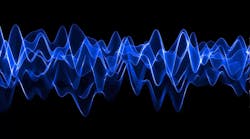Testing unwanted and nonlinear spectral distortion is critical—distortion not only degrades transmitter performance, but also receiver sensitivity. For signal generators, distortion performance is an important attribute that can significantly impact device characterization. In the white paper, “Tactics for Improving Distortion Measurements,” Keysight Technologies explains the different types of distortion along with effective measurement techniques.
The white paper begins by providing a basic definition of distortion, explaining that it’s the alteration of an original waveform. While a linear device does not create distortion, applying an input signal to a nonlinear device can result in an output with a frequency shift or additional frequencies.
Harmonic distortion and intermodulation distortion (IMD) are two major types of nonlinear distortion. Harmonic distortion results in an output with frequency components at integer multiples of the input frequency. IMD is a result of mixing of two or more signals at different frequencies—whether these signals are created in the system or not.
Using a continuous-wave (CW) tone is the most straightforward approach to measuring harmonic distortion, according to the white paper. In such scenarios, the device under test (DUT) could be an amplifier or mixer. A signal generator can be used to provide the input signal to the DUT. The document points out that it’s important to use a generator with low harmonic distortion. Another crucial step is to include a lowpass filter between the signal generator and DUT to ensure that measured harmonics come from the DUT and not the generator. Furthermore, the common two-tone technique for IMD measurements is described. Block diagrams of both harmonic distortion and IMD measurement setups are presented.
The paper notes that the two-tone third-order IMD technique does not completely characterize the behavior of wideband components. Specifically, digital modulation techniques can generate what’s known as spectral regrowth. Examining this type of distortion requires adjacent-channel-power-ratio (ACPR) measurements, which are key for meeting most cellular conformance specifications. For ACPR measurements, the document notes that generating a specific standard-compliant test waveform requires a signal generator with ultra-low-distortion performance.
Keysight Technologies, 1400 Fountaingrove Parkway, Santa Rosa, CA 95403-1738; (800) 829-4444.

